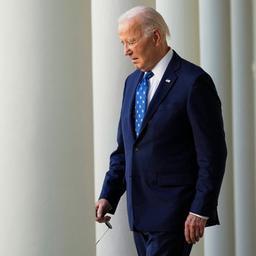Looking Back at the Good Old Days of Growth Under Biden
As the nation navigates the complexities of a post-pandemic economy, a nostalgic reflection on the early years of the Biden administration reveals a moment marked by robust growth, significant job creation, and ambitious policy initiatives. In the wake of unprecedented challenges, the year 2021 emerged as a defining period for economic expansion, characterized by the effective rollout of stimulus measures, an aggressive vaccination campaign, and a renewed focus on infrastructure investment. This article delves into the pivotal policies and economic trends that shaped this brief but impactful era, highlighting the successes and challenges that continue to influence the current economic landscape. As lawmakers and economists assess the path ahead, examining the lessons from those early days under President Biden provides valuable insights into both the potential for recovery and the hurdles that lie ahead.
Reflecting on Economic Rebound and Job Creation During Bidens Tenure
The economic landscape under President Biden has shown resilience, marked by a robust rebound that many analysts attribute to a combination of strategic fiscal policies and a focused pandemic response. Since his administration began, job creation has outpaced expectations, reflecting an eagerness among employers to bridge the gaps left by the pandemic. This surge is evidenced by various sectors seeing notable increases in employment opportunities, contributing to a broader economic revival that transcends the traditional constraints of the labor market. Key factors include:
- Significant Federal Assistance: Stimulus checks and expanded unemployment benefits provided immediate relief and stimulated consumer spending.
- Infrastructure Investments: Initiatives aimed at modernizing infrastructure have fueled job growth in construction and related sectors.
- Focus on Green Energy: Increased investments in renewable energy projects have created thousands of sustainable jobs.
Moreover, the stability in job numbers has led to an increased confidence among consumers and businesses alike. An analysis of labor statistics shows a steady decline in unemployment rates and an uptick in wage growth, indicating that the economy is not just recovering but evolving. The table below illustrates the month-over-month job growth since Biden took office, highlighting the sectors that have contributed significantly to this upward trend:
| Month | Job Growth (in thousands) | Top Sector |
|---|---|---|
| January 2021 | 49 | Leisure and Hospitality |
| April 2021 | 770 | Construction |
| July 2021 | 943 | Professional and Business Services |
| October 2021 | 531 | Health Care |
| March 2022 | 431 | Retail |
As this trajectory continues, the long-term strategy remains focused on fostering a balanced economic environment that supports sustainable growth and job security. By investing in both traditional and emerging industries, the Biden administration aims to create A resilient economy that can withstand future challenges while promoting equity and inclusivity in the labor market. The integration of technology and innovation into various sectors is also prioritized to ensure that the workforce is equipped with the skills necessary for the jobs of tomorrow.
Additionally, ensuring access to education and training programs for unemployed and underemployed individuals remains a key focus. By enhancing workforce development initiatives, the administration aims to address skill gaps and prepare workers for the evolving demands of the economy.
while challenges remain—such as inflation pressures and global supply chain disruptions—the comprehensive approach taken by the Biden administration has laid the groundwork for a sustainable recovery. Continuous monitoring and adaptive strategies will be crucial as the economy navigates through these complexities to achieve lasting prosperity for all Americans.
Analyzing Key Policies that Fueled Growth and Innovation
The past few years have witnessed a paradigmatic shift in the United States as key policies implemented under the Biden administration have driven unprecedented growth across various sectors. Investment in infrastructure, amplified by the Bipartisan Infrastructure Law, paved the way for substantial job creation and enhanced economic activity. This initiative has not only revitalized aging roads and bridges but has also facilitated a nexus of innovation by fostering improved mobility and digital connectivity. Additionally, the administration’s focus on clean energy initiatives has catalyzed advancements in sustainable technologies, attracting investment and bolstering job creation in burgeoning sectors such as renewable energy and electric vehicles.
Furthermore, the administration’s commitment to supporting small businesses through grants and tax incentives has empowered entrepreneurs to explore new markets and innovate. Policies aimed at reducing regulatory burdens have further incentivized startups, leading to a surge in technological advancements. To illustrate the impact of these policies, consider the following table that summarizes key initiatives and their corresponding outcomes:
| Policy Initiative | Key Outcomes |
|---|---|
| Bipartisan Infrastructure Law | Improved job growth, increased public works spending |
| Clean Energy Investments | Boost in renewable energy technology and jobs |
| Support for Small Businesses | Increased entrepreneurial activity, innovation surge |
Moreover, the administration’s proactive stance on technology regulation has sought to balance growth with consumer protection, engendering a more stable market environment conducive to innovation. With measures aimed at preventing monopolistic practices, the Biden administration has reportedly fostered a more competitive landscape for tech companies, leading to a plethora of options for consumers and businesses alike. This focus on balanced regulation, combined with targeted investments, has not only stimulated economic growth but has also positioned the United States as a leader in global innovation.
Identifying Strategies for Sustained Economic Prosperity Moving Forward
As we reflect on the previous administration’s economic initiatives, it becomes crucial to extract lessons learned that can guide future strategies. Key components that contributed to the growth during Biden’s tenure included:
- Investment in Infrastructure: Revamping the nation’s physical framework spurred job creation and stimulated various sectors.
- Green Energy Initiatives: Pushing forward with sustainable energy solutions not only catered to environmental needs but also paved the way for new job markets.
- Support for Small Businesses: Offering grants and relief programs helped to stabilize local economies and promote innovation.
Moving forward, these success stories can inform a broader economic strategy that embraces adaptability and innovation. Policymakers should focus on:
- Workforce Development: Investing in education and skills training to prepare workers for emerging industries.
- Public-Private Partnerships: Encouraging collaborations that harness private sector efficacy while achieving public goals.
- Global Collaboration: Engaging in international trade and alliances to broaden market access and economic resilience.
| Strategy | Potential Impact |
|---|---|
| Invest in renewable energy | Job creation, reduced carbon footprint |
| Enhance digital infrastructure | Improved connectivity, innovation boosts |
| Support tech startups | Multiplier effect on local economies |
To Conclude
As we reflect on the era of economic growth under President Biden, it’s clear that the “good old days” are characterized by a unique blend of policy innovation and unforeseen challenges. While the administration’s strategies, from infrastructure investments to green energy initiatives, laid the groundwork for a resilient economy, the journey has been marked by the complexities of a post-pandemic recovery landscape. As we consider the lessons learned during this period, it becomes evident that sustained growth requires adaptability and a commitment to addressing the evolving needs of the American workforce. As we move forward, the legacies of these initiatives will undoubtedly shape the economic narrative for years to come, prompting both policymakers and citizens to engage in meaningful conversations about the future of growth in America. The question remains: how will we build upon this foundation to ensure even greater prosperity in the decades ahead?






























